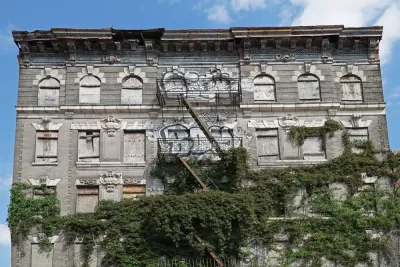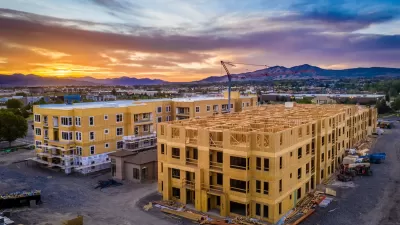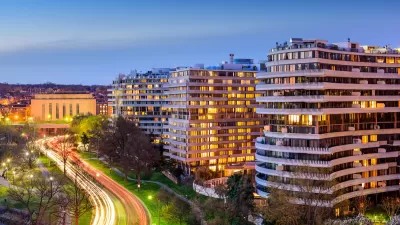Is the existence of vacant apartments an excuse not to build new housing?

One argument against new housing is that old housing is already full of vacancies—so why build new housing when we can just somehow force apartment hunters into the old housing? People who believe this tend to believe that existing vacancies are simply sat on by rich owners, who are waiting for the units to appreciate.
But this argument is wrong for two reasons. First, it is based on the assumption that there is no good reason that an apartment should be vacant. But in fact, vacancies are natural in a functioning market: if an apartment is in the process of being rented or sold, it will be temporarily vacant. If the apartment is being renovated, it will be temporarily vacant. According to the Census Bureau, many vacant housing units are in one of these categories: 8.1 percent of all metro area units are vacant, and nearly half of those are for rent, for sale, or awaiting occupancy. About half of the rest are classified by the Bureau as, "for occasional use" or "temporarily occupied by persons with usual residence elsewhere."*
Second, if vacancies were a result of out-of-control wealth, the most expensive cities would have the highest vacancy rates, and the cheapest cities would have the fewest vacancies. But this is generally not the case—in fact, expensive cities tend to have slightly lower vacancy rates.
First let's look at rental vacancy rates in the most notoriously expensive metro areas—metros with over 4 million people where the median house costs over $400,000. New York's vacancy rate is 4 percent, San Francisco's 3.9 percent, Los Angeles's 3.6 percent, and Boston's a stunningly low 1.7 percent. San Jose, a smaller but extremely expensive metro, has a vacancy rate of only 2.5 percent.
By contrast, let's look at the cheaper large metros, where median housing prices are under $250,000. The largest relatively low-cost metros are Dallas, Houston, Chicago, Philadelphia, Atlanta, and Detroit. Their vacancy rates are, respectively, 6.7 percent, 10.6 percent, 5.7 percent, 8.4 percent, 7.8 percent, and 4.7 percent. Not one of the high-cost metros has a vacancy rate as high as Detroit's 4.7 percent!
Similarly, none of the medium-cost large metros (e.g., Phoenix, Washington, and Miami) have higher vacancy rates than any of the high-cost metros, although Phoenix ties with metro New York at 4 percent, Washington has a higher 5.9 percent rate, and Miami a 7.8 rate. Thus, of the nine large metros where houses cost under $400,000, not one has as many vacancies as San Francisco, Los Angeles, or Boston, and one has a vacancy rate comparable to metro New York.
One possible flaw in the above discussion its limitation to rental vacancies (as opposed to condominiums that are not on the rental market) and includes suburbs. If you look at overall vacancy rates for central cities, the correlation between low cost and high vacancy is less overwhelming—but it still exists.
The four high-cost central cities discussed above have overall housing vacancy rates between 6.4 percent (Los Angeles) and 9.1 percent (New York City). By contrast, the five low-cost cities have higher vacancy rates. Detroit has an astounding 29.2 percent vacancy rate. What about the more prosperous low-cost Sunbelt cities? Atlanta has a 18.2 percent vacancy rate, Houston an 11.1 percent rate, and Dallas a 10 percent vacancy rate. The two low-cost Rustbelt cities (Chicago and Philadelphia) also have double-digit vacancy rates—12.8 percent for Chicago, 13 percent for Philadelphia. The least "vacant" cities still have vacancy rates higher than that of New York City, and not one has a vacancy rate as low as any of the high-cost cities.
What about the central cities of the medium-cost metros? They look more like the central cities of the low-cost metros: Phoenix has a vacancy rate of 10.6 percent, Washington has a vacancy rate of 9.8 percent, and Miami has a vacancy rate of 16.2 percent.
Of course, all of this should be common sense: low supply normally equals high price, and it therefore should not be surprising that places with low vacancy rates have high prices—even if the correlation is somewhat imperfect.
*A more detailed discussion of the types of vacancies can be found on page 8 of a recent paper by Shane Phillips of the UCLA Lewis Center, which focuses in vacancies in Los Angeles.

Montreal Mall to Become 6,000 Housing Units
Place Versailles will be transformed into a mixed-use complex over the next 25 years.

Planetizen Federal Action Tracker
A weekly monitor of how Trump’s orders and actions are impacting planners and planning in America.

DARTSpace Platform Streamlines Dallas TOD Application Process
The Dallas transit agency hopes a shorter permitting timeline will boost transit-oriented development around rail stations.

Without International Immigrants, the Rural US Population Would Be Falling 58%
Census data shows that population growth in rural areas is due in large part to international migrants.

Dead End: Nine Highways Ready for Retirement
The Freeways Without Futures report describes the nation’s most promising highway removal proposals.

Congressman Proposes Bill to Rename DC Metro “Trump Train”
The Make Autorail Great Again Act would withhold federal funding to the system until the Washington Metropolitan Area Transit Authority (WMATA), rebrands as the Washington Metropolitan Authority for Greater Access (WMAGA).
Urban Design for Planners 1: Software Tools
This six-course series explores essential urban design concepts using open source software and equips planners with the tools they need to participate fully in the urban design process.
Planning for Universal Design
Learn the tools for implementing Universal Design in planning regulations.
City of Mt Shasta
City of Camden Redevelopment Agency
City of Astoria
Transportation Research & Education Center (TREC) at Portland State University
City of Camden Redevelopment Agency
Municipality of Princeton (NJ)
Regional Transportation Commission of Southern Nevada






























